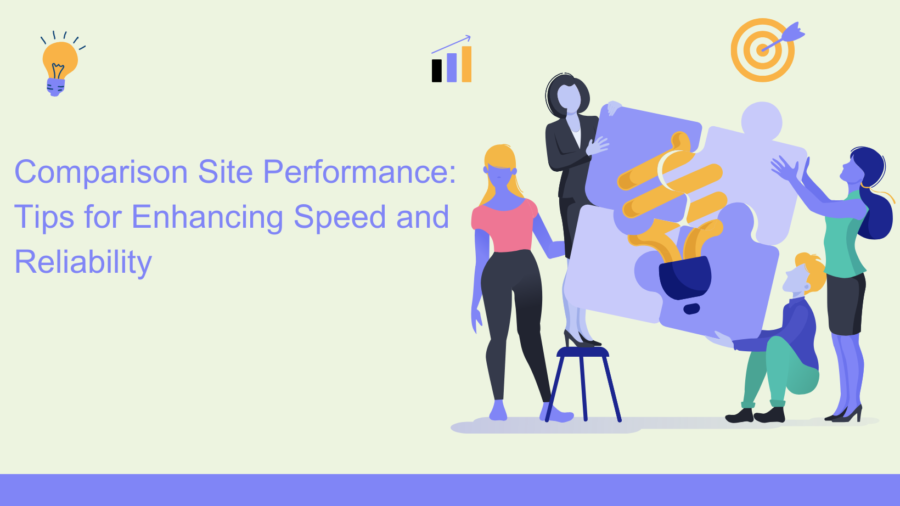The performance of a comparison site is critical to the user experience, SEO rankings, and conversion rates. A slow or unreliable website can result in high Comparison site performance bounce rates, lost revenue, and poor search exposure, therefore speed and reliability are critical for success.
Table of Contents
Introduction
Comparison sites play an important role in assisting consumers in making informed selections, but speed and dependability are essential for keeping visitors engaged. A slow, unresponsive, or frequently unavailable website irritates users, resulting in high bounce rates and lost conversions.
Furthermore, search engines reward sites that load quickly and are well-optimized, therefore speed has a direct impact on SEO rankings. In this post, we’ll look at practical strategies for increasing speed and dependability, assuring a smooth Comparison site performance user experience, and improving search visibility.
Why Speed and Reliability are Important for Comparison Sites
The impact on user engagement and conversions
According to studies, 53% of people quit websites that take more than 3 seconds to load.
Faster pages result in higher conversion rates and improved user retention.

Impact on SEO Rankings and Search Visibility
Google’s Core Web Vitals stress performance metrics such as Largest Comparison site performance Contentful Paint (LCP) and First Input Delay (FID).
Slow sites are penalized in search rankings, resulting in decreased organic visitors.
Trust and Credibility Factors
A speedy and constantly available website fosters user trust.
Downtime and slow performance harmed brand reputation and income.
Optimizing Page Speed to Improve User Experience
Key Strategy:
Minimize HTTP requests – Limit the amount of components that load per page.
Enable caching – Store data to reduce load times for repeat users.
Use Content Delivery Networks (CDNs) to distribute content across multiple global servers for speedier delivery.
Optimize photos by converting them to Comparison site performance WebP format and enabling lazy loading.

Improving server performance and uptime
Selecting the Right Hosting Provider
Choose a high-performance, SSD-based hosting solution.
Ensure that the provider ensures 99.9% uptime.
Using a Reliable Content Delivery System.
Use Cloudflare or Amazon CloudFront for global content distribution.
Reduce latency and improve speed by using globally scattered Comparison site performance servers.
Monitoring uptime and performance.
Use Pingdom, UptimeRobot, or Google Search Console to monitor downtime.
Create real-time warnings for performance issues.
Improving server performance and uptime
Selecting the Right Hosting Provider
Choose a high-performance, SSD-based hosting solution.
Ensure that the provider ensures 99.9% uptime.
Using a Reliable Content Delivery System.
Use Cloudflare or Amazon CloudFront for global content distribution.
Reduce latency and improve speed by using globally scattered servers.
Monitoring uptime and performance.
Use Pingdom or UptimeRobot. Google Search Console to track downtime.
Set up real-time alerts for performance issues.
Mobile optimization ensures smooth performance on all devices.
Steps to Improve the Mobile Experience:
Implement a responsive design that adapts to various screen sizes.
Enable Accelerated Mobile Pages (AMP) to speed up mobile Comparison site performance loading.
Optimize touch elements for better user interaction.
Read More:
The Role of a Comparison Site Guide in Your Digital Marketing Funnel
Creating a Comparison Site Guide That Boosts Your SEO and Traffic
A Comprehensive Comparison Site Guide for Digital Marketers
How to Create a Successful Comparison Site Guide for Your Business
5 Key Features Every Comparison Site Reviews Blog Should Have
Conclusion
A well-optimized comparison site should be quick, dependable, and user-friendly. Site owners may provide a seamless user experience by addressing speed issues, boosting server uptime, optimizing for mobile, and utilizing performance tracking Comparison site performance tools.
Comparison sites that prioritize speed and dependability can improve their search rankings, user engagement, and conversions.
Frequently Asked Questions (FAQs)
Q . What is the ideal page load time for a comparison site?
A. Under 3 seconds for optimal user experience and SEO benefits.
Q. How can I test my site’s reliability and uptime?
A. Use tools like Pingdom, UptimeRobot, and Google Search Console.
Q. Why is mobile optimization important for performance?
A. A mobile-friendly site ranks higher and provides a better user experience.
Q. What are the best free tools for measuring site speed?
A., Google PageSpeed Insights, GTmetrix, and Lighthouse by Google.
Q. How often should I optimize my comparison site’s performance?
A. At least every quarter, with ongoing monitoring for Comparison site performance critical issues.



Add a Comment